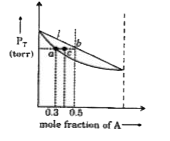Statement 1: Frenkel defect is also called dislocation defect.
Statement 2: Frenkel defect is shown by ionic substances in which cation and anion are of almost similar sizes.Solution in Malayalam
Statement 1 is True, statement 2 is true, statement 2 is correct explanation for statement 1.
Statement 1 is true, statement 2 is true, statement 2 is NOT a correct explanation for statement 1.
Statement 1 is true, statement 2 is false
Statement 1 is false, statement 2 is true
The correct Answer is:C
Frenkel defect is called dislocation defect because smaller ion (generally the cation) is dislocated from its normal site to an interstitial site. It is shown by ionic substances in which there is large difference in the size of ions e.g. ZnS, AgCl.
Topper's Solved these Questions
- BOOK - BRILLIANT PUBLICATIONCHAPTER - SOLID STATEEXERCISE - LEVEL-3 (Linked Comprehension Type)10videos
SOLID STATE
- BOOK - BRILLIANT PUBLICATIONCHAPTER - SOLID STATEEXERCISE - LEVEL-3 (Numerical Type)7videos
SOLID STATE
- BOOK - BRILLIANT PUBLICATIONCHAPTER - REDOX REACTION & ELECTROCHEMISTRYEXERCISE - QUESTION (ELECTROCHEMISTRY) (LEVEL -II) (ASSERTION-REASON)3videos
REDOX REACTION & ELECTROCHEMISTRY
- BOOK - BRILLIANT PUBLICATIONCHAPTER - SOLUTIONSEXERCISE - Level-III (Linked Comprehension Type)12videos
SOLUTIONS
Similar Questions
F centre is an example of metal excess defect due to the presence of extra cations at interstitial sites. Zinc oxide is white in colour at room temperature, on heating it loses oxygen and turns yellow.
ZnOHeat−−→Zn2++12O2+2e−
Now there is excess of zinc in the crystal and its formula becomes Zn1+x O. the excess of Zn2+ ions move to interstitial sites and the electrons to neighbouring interstitial sites.
There are many solids which are difficult to prepare in the stiochiometric composition and contain less amount of the metal as compared to stiochiometric proportion. a typical example of this type is FeO which is mostly found with a composition of Fe0.95. it may actually range from Fe0.96 O.
Q. In Fe0.95 O:02:38View SolutionDiamond structure is based on a face centred cubic lattice where four out of the eight tetrahedral holes are occupied by carbon atoms. Every atom in this structure is surrounded tetrahedrally by four other carbon atoms. How many carbon atoms per unit cell in diamond structure ?
03:07View SolutionAssertion: After the electrolysis of aqueous CuSO4 solution pH decreases.
Reason: Sulphuric acid is formed.01:21View Solution1 mole of A and 1 mole B are mixed together to form an ideal solution at 25∘C. Solution is placed in a vessel fitted with piston. If pressure on the solution is reduced isothermally.

Correct relationship between P∘AandP∘B is02:12View SolutionStatement : Due to Frenkel defect the density of the crystalline solid remains same.
Explanation : In Frenkel defect, no cations or anions leave the lattice.02:23View SolutionFrenkel defects asre observed where the differnce in size of cation and anion is large
02:21View Solution(A) KCL is more likely to show Schottky defect ,while Li is more likely to show Frenkel defect. (R) Schottly defect is found in those ionic solid which have cation and anion of similar size while Frenkel defect is more likely found in those solids which have cation of smaller size.
02:22View SolutionAssertion : Due to Frenkel defect, density of the crystalline solid decreases. Reason : In Frenkel defect, cation or anion leaves the crystal.
View SolutionAssertion:Frenkel defect is also called dislocation defect Reason:Frenkel defect is shown by ionic substances in which cation and anion are of almost similar sizes.
01:47View SolutionAssert : due to Frenkel defect, density of the crystalline solid decrases. Reason : in Frenkel defect cation and anion leaves the crystal.
04:52View SolutionThe size of the anion in Frenkel defect crystal is "_____________"
02:24View SolutionAssertion : due to Frenkel defect, density of the crystalline solid decreases. Reason : in Frenkel defect cation and anion leaves the crystal.
01:44View SolutionAssertion : In Frenkel defect, density of the crystalline solid does not change.
Reason : In Frenkel defect, no cation or anion leaves the crystal.04:49View Solutionअभिकथनः फ्रेंकेल दोष को विस्थानीय दोष (Dislocation defect) भी कहते हैं।
तर्कः फ्रेंकेल दोष आयनिक पदार्थों के द्वारा प्रदर्शित किया जाता है जिसमें धनायन और ऋणायन प्रायः समान आकार के होते हैं।05:47View SolutionStatement : Due to Frenkel defect the density of the crystalline solid remains same.
Explanation : In Frenkel defect, no cations or anions leave the lattice.03:42View SolutionAssertion:Frenkel defect is also called dislocation defect
Reason:Frenkel defect is shown by ionic substances in which cation and anion are of almost similar sizes.03:31View Solution

